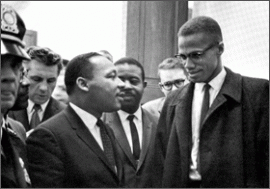Martin Luther King, Jr., and Malcolm X: A Common Solution
Introduction
“There is a regrettable tendency to turn our heroes into icons and to take away some of the legitimate activities that were part of their personal and political biography, to freeze them at a stage in their development.” —Manning Marable, 1992
Years after the deaths of Martin Luther King, Jr., and Malcolm X, the two men still remain fixed images in the American consciousness: Martin Luther King, Jr., an advocate of nonviolence, delivering his “I Have a Dream” speech from the steps of the Lincoln Memorial, and Malcolm X, the black nationalist, encouraging African Americans to fight racial oppression “by any means necessary.”
Were these two men really ideological opposites? Did they share any common ground? Were their thoughts about each other and the struggle for African American liberation changing in the years leading up to their assassinations? Is it possible that the two leaders may have converged, if not for their untimely deaths?
While many students are familiar with Martin Luther King, Jr., the civil rights leader, most are totally unfamiliar with his call to bring an end to the Vietnam War or his efforts to bring about economic justice. Students’ knowledge of Malcolm X is even more limited; few, if any, know of X’s efforts to correspond with King or of the dramatic shift in his racial attitudes that followed his trip to Mecca.
The primary goal of this lesson is to challenge students’ preconceived notions about Martin Luther King, Jr. and Malcolm X and the roles they played in the African-American Freedom Struggle. While there is certainly much to be learned by examining the different philosophies and tactics of each leader, these two men, who combined their religious leadership with political action, have much more to teach us as we explore how their vision for racial justice developed into a call for social and economic equality and human rights.
Student Objectives
- To explore the ideological and political development of Martin Luther King, Jr., and Malcolm X through primary source documents
- To identify the various personal, social, and political factors that influenced Martin Luther King, Jr., and Malcolm X’s leadership
- To understand the opposing philosophies and tactics of King and X, as well as areas in which their ideas converged
Era 9: Postwar United States, Standard 4a
Photo credit. King and Malcolm X meet for the first, and only time, following King’s 26 March 1964 testimony before Congress. Courtesy of the Library of Congress Prints and Photographs Division, Washington, D.C.
Essential Question
- 1
In what areas did Martin Luther King, Jr. and Malcolm X’s ideas converge?


